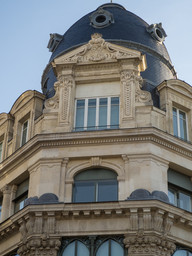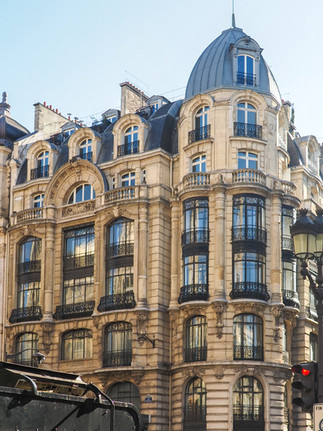Rue Réaumur: a symbol of transition between the "Haussmannian" style and modern movements
- EG-xiste

- Oct 31, 2021
- 9 min read
Updated: Jun 4, 2023
Photos : E.G © 2021
The architectural landscape of the capital has been shaped for six centuries, from old Paris to Greater Paris by 2030. But as soon as we talk about Parisian architecture, the "Hausmannien" style is the first to come to mind.
This transformation of Paris, carried out under the Second Empire in barely 20 years, represented a complete upheaval of the urban landscape and social mix, with the construction of a vast network of major axes.
The Baron Haussmann , with the law of 26 March 1852 and the Decree of 21 September 1855, requires construction of these new arteries to respect the lines of unit compositions.
The main Haussmannian easements
The ground floor and the mezzanine must have basement walls with partitions, "bossage".
The second floor, known as the "noble" floor, must have one or two balconies.
The 3rd and 4th floors must be the same style as the 2nd floor but without a balcony.
The 5th floor must have a continuous balcony to maintain harmony with the 2nd floor, but without decoration.
Roof spaces 45 degrees, less rich.

This regulation is therefore at the origin of the modeling of these facades so characteristic of Haussmannian Paris. The buildings of an island have the same height, which reinforces the impression of the architectural ensemble. Each of them respect the same horizontal lines of facade, with little decoration, few setbacks and few protrusions.
1882-1902 the years of the rupture
But with the fall of the Empire and especially from the 1880s, the easements imposed in the specifications of the Haussmann era will gradually be lightened and amended.
It must be said that this imposed uniformity is starting to tire. The "Haussmannian" regulations paralyzed architects by curbing their creativity.
From 1882 and for twenty years, construction in the capital will experience a phase of great productivity and creativity. The arrival of new materials - iron and concrete - will gradually give birth to a new architecture. That of the elevator in 1885 will definitively requalify the upper parts of the buildings into noble parts and serve as a creative emulation for these formerly neglected floors.
Rue Réaumur the end of pure "Haussmannian" style
Between 1895 and 1897, a new extension of rue Réaumur was drilled over more than 600 meters between the Palais Brongniart (the stock exchange) and the Arts et Métiers.
The street was inaugurated by President Félix Faure in 1897, it has a commercial or even industrial vocation for a large majority of high-rise buildings.
Taking advantage of the successive modifications and relaxations of the strict Haussmannian regulations, it will become a place of architectural experimentation along its entire length.
The creation of the Concours de façades de la ville de Paris in 1898 following the construction of this new artery will encourage architects in the erection of original buildings.
Réaumur street can be considered as the real marker of the end of the pure "Haussmannian" era, the symbol of a new architectural landscape, a period of transition before the arrival of modern movements.

I invite you to discover the main achievements that run along Réaumur street between Bourse metro station and Réaumur-Sébastopol , in chronological order of construction.
At 101 - Architect Albert Walwein - 1895
Commercial building
This commercial building is located at the corner of Cléry street . It has a powerful elevation with a corner rotunda on two levels. An eclectic ornamentation around the openings, sheathed caryatids of neo-renaissance style frame a bay on the second floor and bear a pediment. The sculptures are by Jacques Perrin.

The main part of this building is dominated by bay windows framed by pilasters with Corinthian capitals.

The ornate pediment, garlands and sheathed caryatids.

At 82-92 - Architect F. Constant-Bernard - 1897
Commercial building
One of the first commercial buildings on the street, it hosted in its time, the store " A Réaumur ", the first brand to offer the sale of ready-to-wear by mail order with deliveries by horse-drawn carriage. The main attraction of this building is the monumental polychrome mosaic clock, in an Art Nouveau style, in the name of the brand.


The facade is made up of a colossal order with pilasters on two levels which frame the bay windows on a metal structure.
At 91 - Architect Charles de Montarnal - 1897
Activities building
Activities building on a metal structure and stone cladding. Total sobriety of the facade made up of five bays with a strong predominance of bay windows on a thin metal frame.

At 93 - Architects Léon Bonnenfant & Denis Destors - 1898
Commercial building
Building with cutaway and metallic structure with stone cladding. As with many buildings in the street, there is a strong predominance of bay windows. They each have in their center a column with Corinthian capitals and are separated by pilasters.

The rest of the ornamentation is discreet; consoles with scrolls and lion's heads for the balconies, hanging balustrade for the attic.

At 108-110 - Architect Edouard Wattier - 1898-1899
Commercial buildings
Twin buildings built on two plots. They have two massive corner turrets which accentuate the verticality of the whole. A composition of large glass bays on the first floors with a fairly conventional treatment on the upper floors.

At 116 - Architect Albert Walwein - 1897-1898
Commercial building
Freestone building for commercial use. The ornamentation is mainly concentrated above the entrance porch.
The upper balcony is supported by two monumental sculptures of Atlanteans which rest on crows in the shape of a lion's head.
The triangular pediment of the door is composed of a medallion representing Venus and two loves.


At 130 - Architect Charles de Montarnal - 1898
Commercial building
Corner building with rotunda, metal structure and stone cladding. Once is not custom, strong domination of the bay windows separated by pilasters with composite capitals. The dormers with their triangular pediments break the roof line. Unlike n ° 118, the architectural vocabulary remains very academic and classical.

Pediment of the metal entrance gate.

Iron and glass for shops, workshops or offices often on 3 or 4 floors.
The upper floors, reserved for accommodation, remain mostly dressed in freestone.
At 105 - Architect Charles Ruzé - 1899
Commercial building
Minor achievement by Charles Ruzé compared to the one produced a year later at 121.
At 126 - Architect Albert Le Voisvenel - 1899
Commercial building
Cutaway building with a facade with metal structure spans, covered with a stone boss. The spans of the central part form a large bay window and the ironwork is worked differently on each floor, like this lowered arch.

At 61-63 : Architects Pierre Jouannin et G. Sirgery - 1900
Activities building
One of the most surprising buildings on the street. This monumental construction is a mixture of Art Nouveau and Neo-Gothic Art, a combination of a very eclectic style in the midst of the industrial revolution. The illusion of a religious building is accentuated by its central part. An entrance similar to those of churches, surmounted by twin windows, ribs and a mosaic rose window which houses a clock.
We also notice a very strong inspiration from the architectural vocabulary of the followers of Violet-le-Duc .


The sculptures are made by the Jacquier family business . The floral motifs that adorn the cornices and columns complete the main theme of the sculptures on the facade: time . Indeed, the rose window shelters around the clock, the signs of the zodiac and the months of the year.
After the rose window, we find under the twin windows a new animal representation carved with these signs. The set is framed by four medallions representing the seasons.
The central part resembles a church wrapped in a more modern facade.
Here it should be noted the narrowness of the building with a depth of only five meters.

At 97-99 : Architects Charles Duvillard & Philippe Jolivald - 1900
Investment building
Mixture of freestone and a large glazed surface with an ornate metal structure.
It is a building very representative of the end of Haussmannian rigor, but on the other hand the use of new techniques has not for all that given rise to a new form. The culture of the bourgeoisie at the start of the century is still prevalent.
Note that this building has the particularity of serving as an entrance to the Sentier metro station .

At 118 - Architect Charles de Montarnal - 1900
Commercial building
Here is the most famous achievement of Charles de Montarnal , author of the many commercial buildings in Paris.
It owes its fame due to the huge bay window which occupies a large part of the facade and more particularly to the impressive arch on its upper part. Unlike the 97-99 building, the architect here brilliantly exploited the possibilities offered by metal construction, both in its structure and in its ornamentation.

A freestone frame, a large metal canopy on three levels and across the entire width of the building. The structure and ornamentation, made up of capitals and balustrades, illustrate a beautiful adaptation to the Art Nouveau aestheticism.
The plant windings of the stone parts which frame the glass roof are in perfect harmony with those which animate the cast iron of the metal structure.
At 119 - Architect Germain Bousson - 1900
Commercial building
This building, built on a metal framework, is characteristic of the post-Haussmann period. The commercial destination is clearly demonstrated with the importance of the glass openings. But this framework is heavily masked freestone while easily fitting into the linear of the Réaumur street.

Details of the upper part of the building, a little kitsch dome, and the cut stone envelope gives the effect of a gangue by hiding the metal structure too much.
At 121 - Architect Charles Ruzé - 1900
Investment building
After the 118 and 124, perhaps one of the most beautiful achievements of the Réaumur street with its trefoil corner rotunda and endowed with thin metal frame bow windows.

Beyond the rotunda, the facades seem to be indented by the domed metal bays of the interior with their curved glazing.

At 124 - Attribute to architect Georges Chedanne - 1905
Industrial building
It is on the basis of the deposit of the plans for a building permit that this building is attributed to the architect Georges Chedanne , plans which do not correspond in any way to the final realization. The mystery remains unsolved because this building is poles apart from all of Georges Chedanne's work .
Nevertheless, here we are facing the real jewels of this artery, it alone marks the real break with the Haussmannian past.
Unlike his neighbors, the architect here frees himself from the use of stone, his almost entirely metallic facade is devoid of any ornament and shows a new radicalism.
Steel is used as a real means of formal expression and the harmony between facade and supporting structure is perfect.

The structure is made of riveted I-shaped metal beams, the only expressive vector of an architectural aesthetic. Each level of elevation is separated by a massive joist, and only the top floor and the attic, set back, have no metal structure.
The vertical beams are much thinner, they delimit the spans and are joined on the ground floor by the bow-window consoles.

This break is complete with the trio of metal bow windows hanging on the facade.

The ornamentation of the facade ... is the structure itself.
The formal references to Art Nouveau nuance the geometric rigor of the vertical and horizontal alignments. And more particularly on the ground floor, the curves of the access doors break the linearity of the whole.

The Art Nouveau references are found on the consoles carrying the bow-windows, more particularly on the ground floor and the front door.

At 51 - Architect Charles Le Maresquier - 1910
Commercial building
This emblematic building, headquarters of the Félix Potin group, was built six years after the one in rue de Rennes. It is often nicknamed " the Poivrière " in reference to the large dome which overhangs it.
Le Maresquier seems stimulated by the outrageous demand of Maison Félix Potin and there is no question of economy of means to build this building.
Here is an eclectic neo-baroque architecture, very far from Haussmannian standards. Surprising by the richness and heaviness of its decorations, this building resembles an ornamental trinket.
It seems to be a whim of the sponsor, then in full entrepreneurial success.

And how to magnify the triumph of commerce? By using and abusing ornamental details.
At 132-134 - Architect Jacques Hermant - 1910
Investment building
This investment property is quite characteristic of the transitional period represented by Réaumur street . The architect realizes here a building without radicality. Old forms, in a historicist style, compete with a good density of glass surfaces, thanks to the use of technical advances at the beginning of the century. Its street corner location accentuates the urbanity of this achievement.

Paris underwent under the Second Empire with Baron Haussmann a real architectural revolution which deeply marked its urban history. This architectural cataclysm will be a catalysis for the later architectural currents. There will be those who refer to it, those who adapt it and those who oppose and reject it.
At the beginning of the 1880s, the town planning regulations will gradually soften to stop the discontent of architects, who for too long have felt constrained in the exercise of their profession.
And it is truly with the urban planning regulations of 1902 that the Parisian urban landscape is transformed. The rise of buildings, in theory without limit, upsets the classic uniform and linear street.
And at the start of the 20th century, the architects of Réaumur street offered us a remarkable catalog of architectural styles, finally giving free rein to creativity and fantasy (monumental sculptures, domes, domes, loggias and bow windows), with the use of new materials (iron and concrete).
As you may have noticed, this Réaumur street is one of the first routes to offer a new architectural landscape, a renaissance of autonomy and the individualization of facades.
The post-Haussmannian transition is underway.
Modern movements are still in the posture, Art Nouveau is more and more present but the period will be ephemeral before the emergence of rationalists, functionalists and Art Deco.
A non-exhaustive plan for those who wish to find the buildings mentioned.
Follow Réaumur from the Bourse metro to Réaumur-Sébastopol or vice versa.


























































































































































Comments